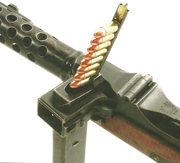No edit summary |
No edit summary |
||
| Line 24: | Line 24: | ||
==History== |
==History== |
||
| − | Development of the S1-100 began in Germany in 1924, at the firm of [[Rheinmetall]] |
+ | Development of the S1-100 began in Germany in 1924, at the firm of [[Rheinmetall]], where [[Louis Stange]] produced a set of blueprints. Rheinmetall, however, was blocked from domestically manufacturing the gun under the terms of the Treaty of Versailles. In 1928, Rheinmetall acquired a Swiss munitions company, Waffenfabrik Solothurn AG, and a year later, Stange took the blueprints to Solothurn and oversaw the construction of the first prototype models. The chief designer on the project was Theodore Rakula. Rheinmetall hoped that they could use Solothurn as a proxy under which they could produce the weapon legally outside of Germany's borders, however it became apparent that Solothurn lacked the manufacturing capacity to produce large quantities of the gun. |
Still seeking to get the S1-100 into production, Solothurn bought the Austrian firm of [[Steyr]] and began manufacturing the weapon at their factories in the early 1930s. It was offered for export sale in a variety of different chamberings and saw some relatively limited success in South America. In 1934, the Austrian Army adopted the S1-100 in [[9×23mm|9×23mm Steyr]] and designated it the '''MP34'''. The Austrian Police also adopted the weapon, but in the [[9×25mm Mauser]] cartridge. |
Still seeking to get the S1-100 into production, Solothurn bought the Austrian firm of [[Steyr]] and began manufacturing the weapon at their factories in the early 1930s. It was offered for export sale in a variety of different chamberings and saw some relatively limited success in South America. In 1934, the Austrian Army adopted the S1-100 in [[9×23mm|9×23mm Steyr]] and designated it the '''MP34'''. The Austrian Police also adopted the weapon, but in the [[9×25mm Mauser]] cartridge. |
||
Revision as of 23:36, 29 January 2019
The S1-100, also known under its Austrian military designation MP34, was a German-designed submachine gun that was produced by Waffenfabrik Solothurn and Steyr.
History
Development of the S1-100 began in Germany in 1924, at the firm of Rheinmetall, where Louis Stange produced a set of blueprints. Rheinmetall, however, was blocked from domestically manufacturing the gun under the terms of the Treaty of Versailles. In 1928, Rheinmetall acquired a Swiss munitions company, Waffenfabrik Solothurn AG, and a year later, Stange took the blueprints to Solothurn and oversaw the construction of the first prototype models. The chief designer on the project was Theodore Rakula. Rheinmetall hoped that they could use Solothurn as a proxy under which they could produce the weapon legally outside of Germany's borders, however it became apparent that Solothurn lacked the manufacturing capacity to produce large quantities of the gun.
Still seeking to get the S1-100 into production, Solothurn bought the Austrian firm of Steyr and began manufacturing the weapon at their factories in the early 1930s. It was offered for export sale in a variety of different chamberings and saw some relatively limited success in South America. In 1934, the Austrian Army adopted the S1-100 in 9×23mm Steyr and designated it the MP34. The Austrian Police also adopted the weapon, but in the 9×25mm Mauser cartridge.
When Germany invaded Austria in 1938, the Wehrmacht and SS acquired the majority of the Austrian service S1-100s and issued them to their own troops under the designation MP34(ö). It saw some limited use by German troops, but was largely overshadowed by the more commonly-used MP40. During the Second Sino-Japanese War, the S1-100 was exported in small numbers to both the Chinese and Japanese armies, seeing minor combat use by both sides. Production of the gun ceased in 1940.
Design

The S1-100's unique magazine charger.
The S1-100 was a blowback-operated submachine gun that fired from an open bolt. It used a loose firing pin and the bolt's return spring was unusually located within the stock. The upper half of the receiver was hinged and could be lifted open for easy disassembly.
Like most German-designed submachine guns of the period, it fed from the left side of the receiver and incorporated a perforated barrel jacket. A bayonet could be attached to the right side of the barrel. Some later models included magazine housing that had a upward-facing gate from which the user could insert an empty magazine vertically and then feed the rounds in using a charger.

